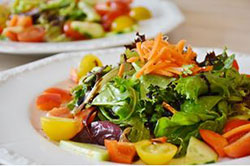by J. Clifford and J. Curely * (12/19)
Quick Facts…
- B-complex vitamins and vitamin C are water-soluble vitamins that are not stored in the body and must be consumed each day.
- These vitamins can be easily destroyed or washed out during food storage and preparation.
- The B-complex group is found in a variety of foods: cereal grains, meat, poultry, eggs, fish, milk, legumes and fresh vegetables.
- Citrus fruits, peppers, strawberries, kiwis, and broccoli are good sources of vitamin C.
- Using mega-doses of multivitamins or supplements is not recommended.
What are Vitamins?
Vitamins are essential nutrients found in foods. They perform specific and vital functions in a variety of body systems, and are crucial for maintaining optimal health.
The two different types of vitamins are fat-soluble vitamins and water-soluble vitamins. Fat-soluble vitamins — vitamins A, D, E and K — dissolve in fat before they are absorbed in the bloodstream to carry out their functions. Excesses of these vitamins are stored in the liver, and are not needed every day in the diet. For more information on fat-soluble vitamins, see fact sheet 9.315 Fat-Soluble Vitamins: A, D, E, and K.
In contrast, water-soluble vitamins dissolve in water and are not stored by the body. Since they are eliminated in urine, we require a continuous daily supply in our diet. The water-soluble vitamins include the vitamin B-complex group and vitamin C.
Water-soluble vitamins are easily destroyed or washed out during food storage or preparation. Proper storage and preparation of food can minimize vitamin loss. To reduce vitamin loss, always refrigerate fresh produce, keep milk and grains away from strong light, and avoid boiling vegetables with the exception of soups where the broth is eaten.
What are Water-Soluble Vitamins?

B-complex Vitamins
Eight of the water-soluble vitamins are known as the vitamin B-complex group: thiamin (vitamin B1), riboflavin (vitamin B2), niacin (vitamin B3), vitamin B6 (pyridoxine), folate (folic acid), vitamin B12, biotin and pantothenic acid. The B vitamins are widely distributed in foods, and their influence is felt in many parts of the body. They function as coenzymes that help the body obtain energy from food. The B vitamins are also important
Thiamin: Vitamin B1
What is Thiamin. Thiamin, or vitamin B1, helps to release energy from foods, promotes normal appetite, and plays a role in muscle contraction and conduction of nerve signals.
Food Sources for Thiamin. Sources include pork, legumes, fish, peas, and liver. Most commonly, thiamin is found in whole grains and fortified grain products such as cereal, and enriched products like bread, pasta, rice, and tortillas. The process of enrichment adds back nutrients that are lost when grains are processed. Among the nutrients added during the enrichment process are thiamin (B1), niacin (B3), riboflavin (B2), folate and iron.
How much Thiamin. The Recommended Dietary Allowance (RDA) for thiamin is 1.2 mg/day for adult males and 1.1 mg/day for adult females (Table 1).
Thiamin Deficiency. Under-consumption of thiamin is rare in the United States due to wide availability of enriched grain products. However, certain groups may be at risk for thiamin deficiency including people with alcohol dependence, people with HIV/AIDS, people who have undergone bariatric surgery, and those with low dietary intake, like older adults. Alcoholics are especially prone to thiamin deficiency because alcohol reduces thiamin absorption and storage, and excess alcohol consumption often replaces food or meals. Symptoms of thiamin deficiency include: mental confusion, muscle weakness, wasting, water retention (edema), enlarged heart, and the disease known as beriberi. Thiamin deficiency is currently not a problem in the United States.
Too much Thiamin. No problems with overconsumption are known for thiamin.
Riboflavin: Vitamin B2

What is Riboflavin. Riboflavin, or vitamin B2, helps to release energy from foods, and is also important for the growth, development and function of the cells in the body. It also helps to convert the amino acid tryptophan (which makes up protein) into niacin.
Food Sources for Riboflavin. Sources include eggs, organ meats (liver and kidney), dark green vegetables, milk, and whole and enriched grain products. Ultraviolet light is known to destroy riboflavin, which is why most milk is packaged in opaque containers instead of clear.
How much Riboflavin. The Recommended Dietary Allowance (RDA) for riboflavin is 1.3 mg/day for adult males and 1.1 mg/day for adult females (Table 1).
Riboflavin Deficiency. Under consumption of riboflavin is extremely rare in the United States. Groups at risk of riboflavin inadequacy include vegan athletes and pregnant and breastfeeding women and their babies. Symptoms of deficiency include skin disorders, cracks at the corners of the mouth, hair loss, itchy and red eyes, reproductive problems, and cataracts.
Too much Riboflavin. No problems with overconsumption are known for riboflavin.
Niacin: Vitamin B3, Nicotinamide, Nicotinic Acid.
What is Niacin. Niacin, or vitamin B3, is involved in energy production and critical cellular functions.
Food Sources for Niacin. Niacin is present in a wide variety of foods including animal and plant sources.
How much Niacin. The Recommended Dietary Allowance (RDA) for niacin is 16 mg/day for adult males and 14 mg/day for adult females (Table 1).
Niacin Deficiency. Niacin deficiency is not a problem in the United States and is mostly limited to people who eat very limited diets and diets low in protein. Pellagra is the disease state that occurs as a result of severe niacin deficiency. Symptoms include skin problems, digestive issues, and mental confusion.
Too much Niacin. Consuming large doses of niacin supplements beyond 35mg/day may cause flushed skin, rashes, hypotension symptoms, or liver damage (Table 2). Over-consumption of niacin is not a problem if it is obtained through food.
Vitamin B6: Pyridoxine, Pyridoxal, Pyridoxamine
What is Vitamin B6. Vitamin B6, otherwise known as pyridoxine, pyridoxal or pyridoxamine, aids in protein metabolism, red blood cell formation, and behaves as an antioxidant molecule. It is also involved in the body’s production of chemicals such as neurotransmitters and hemoglobin.
Food Sources for Vitamin B6. Sources include legumes, organ meats, fish, meats, starchy vegetables, and whole grains and fortified cereals.
How much Vitamin B6. The Recommended Dietary Allowance (RDA) for vitamin B6 is 1.3 mg/day for adult males and females through age fifty (Table 1). The RDA for male and females over fifty years of age is 1.7 mg and 1.5 mg, respectively.
Vitamin B6 Deficiency. Vitamin B6 deficiency is uncommon and usually associated with low concentrations of other B-complex vitamins, like vitamin B12 and folic acid. Deficiency symptoms include dermatitis, swollen tongue, peripheral neuropathy, anemia, depression and confusion, and weakened immune function. A vitamin B6 deficiency in infants can cause irritability, acute hearing issues, and convulsive seizures.
Too much Vitamin B6. Over consumption from food sources have not been reported to cause adverse health effects, but chronic excess doses of vitamin B6 from supplements have been known to result in nerve damage (Table 2). The Food and Nutrition Board (FNB) has established an upper limit of 100 mg/day for adults.
Folate: Folic Acid, Folacin
What is Folate. Folate, also known as folic acid or folacin, aids in protein metabolism, promoting red blood cell formation, and lowering the risk for neural tube birth defects. Folate may also play a role in controlling homocysteine levels, thus reducing the risk for coronary heart disease.
Food Sources for Folate. Sources of folate include liver, kidney, dark green vegetables, meats, legumes, fish, whole grains, and fortified grains and cereals. Check the nutrition label to see if folic acid has been added.
How much Folate. The Recommended Dietary Allowance (RDA) for folate is 400 mcg/day for adult males and females. Pregnancy will increase the RDA for folate to 600 mcg/day (Table 1).
Folate Deficiency. Folate deficiency affects cell growth and protein production, which can lead to overall impaired growth. Anemia is the primary clinical sign of folate deficiency and includes symptoms like fatigue, headache, and heart palpitations. A folate deficiency in women who are pregnant or of child bearing age may result in the delivery of a baby with neural tube defects, such as spina bifida. (Table 1).
Too much Folate. Over consumption of folate offers no known benefits, and may mask B12 deficiency as well as interfere with some medications (Table 2). For this reason, the FNB established an upper limit for folate from supplements or fortified foods of 1000 mcg/day.
Vitamin B12: Cobalamin
What is B12. Vitamin B12, also known as cobalamin, aids in the building of genetic material, production of normal red blood cells, and maintenance of the nervous system.

Food Sources for Vitamin B12. Vitamin B12 can only be found naturally in foods of animal origin such as meats, liver, kidney, fish, eggs, milk and milk products, oysters, shellfish. Some fortified foods, like breakfast cereals and nutritional yeast may also contain vitamin B12.
How much Vitamin B12. The Recommended Dietary Allowance (RDA) for vitamin B12 is 2.4 mcg/day for adult males and females (Table 1). Many adults over the age of fifty do not get enough vitamin B12, the dietary guidelines recommend consuming foods fortified with vitamin B12, such as fortified cereals.
Vitamin B12 Deficiency. Vitamin B12 deficiency most commonly affects vegans, infants of vegan mothers, and the elderly. Symptoms of deficiency include anemia and neurological changes, such as numbness and tingling in the hands and feet. In order to prevent vitamin B12 deficiency, a dietary supplement should be taken. Some people develop a B12 deficiency because they cannot absorb the vitamin through their stomach lining. This can be treated through vitamin B12 injections.
Too much Vitamin B12. No problems with overconsumption of vitamin B12 are known.
Biotin
What is Biotin. Biotin helps release energy from carbohydrates and aids in the metabolism of fats, proteins and carbohydrates from food.
Food Sources for Biotin. Sources of Biotin include liver, kidney, egg yolk, milk, most fresh vegetables, yeast breads and cereals.
How much Biotin. The Adequate Intake (AI) for Biotin is 30 mcg/day for adult males and females (Table 1).
Biotin Deficiency. Biotin deficiency is uncommon. A few of the symptoms of biotin deficiency include hair loss, skin rashes, and brittle nails, and for this reason biotin supplements are often promoted for hair, skin, and nail health. However, these claims are only a few case reports and small studies.
Too much Biotin. No problems with overconsumption are known for Biotin.
Pantothenic Acid: Vitamin B5
What is Pantothenic Acid. Pantothenic Acid, also known as vitamin B5, is involved in energy production, and aids in the formation of hormones and the metabolism of fats, proteins, and carbohydrates from food.
Food Sources for Pantothenic Acid. Almost all plant- and animal- based foods contain pantothenic acid in varying amounts. Richest dietary sources include fortified breakfast cereals, liver, kidney, meats, and seeds.
How much Pantothenic Acid. The Adequate Intake (AI) for Pantothenic Acid is 5 mg/day for both adult males and females (Table 1). Pregnancy will increase the AI for Pantothenic Acid to 6mg /day (Table 1).
Pantothenic Acid Deficiency. Pantothenic Acid deficiency is uncommon due to its wide availability in most foods.
Too much Pantothenic Acid. No problems with overconsumption are known for Pantothenic Acid. Rarely, diarrhea and gastrointestinal distress will occur with excessive amounts.
Vitamin C: Ascorbic Acid, Ascorbate
What is Vitamin C

The body needs vitamin C, also known as ascorbic acid or ascorbate, to remain in proper working condition. Vitamin C benefits the body by holding cells together through collagen synthesis; collagen is a connective tissue that holds muscles, bones, and other tissues together. Vitamin C also aids in wound healing, bone and tooth formation, strengthening blood vessel walls, improving immune system function, increasing absorption and utilization of iron, and acting as an antioxidant.
Vitamin C works with vitamin E as an antioxidant, and plays a crucial role in neutralizing free radicals throughout the body. Through its antioxidant activity, studies suggest vitamin C may help prevent or delay the development of certain cancers, heart disease, and other diseases in which oxidative stress plays a causal role. Research continues to document the degree of these effects.
Food Sources for Vitamin C. Many fruits and vegetables contain vitamin C, the best sources are citrus fruits, peppers, kiwi, strawberries, and broccoli. For example, one orange, one kiwi, 6 oz. (3/4 cup) of grapefruit juice, or 1/3 cup of chopped sweet red pepper each supply enough vitamin C for one day.
How much Vitamin C. The Recommended Dietary Allowance (RDA) for Vitamin C is 90 mg/day for adult males and 75 mg/day for adult females (Table 1). For those who smoke cigarettes, the RDA for vitamin C increases by 35 mg/day, in order to counteract the oxidative effects of nicotine. Vitamin C recommendations also increase during pregnancy and lactation, see Table 1.
Vitamin C Deficiency. Although rare in the United States, severe vitamin C deficiency may result in the disease known as scurvy, causing fatigue and a loss of collagen strength throughout the body. Loss of collagen results in loose teeth, bleeding and swollen gums, and improper wound healing.
The following conditions have been shown to increase vitamin C requirements (Table 1):
- Environmental stress, such as air and noise pollution
- Tissue healing of wounds
- Growth (children from 0- 12 months, and pregnant women)
- Fever and infection
- Smoking
Too Much Vitamin C. Despite being a water-soluble vitamin that the body excretes when in excess, vitamin C overdoses an increase the risk of adverse health effects, like kidney stones, diarrhea, rebound scurvy, and increased oxidative damage. For this reason, the FNB has established an upper limit of 2000 mg/ day.
Can Vitamin C Prevent/Treat the Common Cold?
The controversy over using mega doses of vitamin C to prevent or treat the common cold and other infections remains a popular topic. Vitamin C appears to have the ability to enhance various immune cell functions, however, the precise dose and ideal timing of vitamin C intake has not been fully elucidated. Overall, the evidence suggests that adequate dietary vitamin C intake and possibly higher intake at plasma saturating levels (100-200 mg/day) may help prevent the common cold by optimizing cell and tissue levels. Regular intake at doses of 200- 1000 mg/day may be especially helpful in reducing cold incidence in people exposed to extreme physical exercise or cold environment and those with marginal vitamin C status, such as the elderly and chronic smokers. Among the general population, vitamin C intake at doses of 200 mg/day or more is moderately effective in improving the severity and duration of the common cold. In terms of treatment of established infections, some evidence indicates significantly higher doses (grams) may be beneficial in the recovery process by ameliorating the decline in leukocyte vitamin C levels; however, further research still needs to address safety concerns. Furthermore, this effect appears to have the most benefit on those with very low vitamin C levels.
Summary
- Water-soluble vitamins include the vitamin B-complex and vitamin C, and are essential nutrients needed daily by the body in very small quantities.
- The B-complex vitamins can be found in a variety of enriched foods like cereal grains and breads, as well as other foods such as meat, poultry, eggs, fish milk, legumes, and fresh vegetables. Vitamin C can be found in a many fruits and vegetables.
- Overall, in the United States deficiency is rare for B vitamins and vitamin C; with exceptions for alcoholics, those on very limited diets, and the elderly.
- Special attention should be paid to folate (folic acid) intake during pregnancy, in order to avoid birth defects.
- Vegans should be conscious of vitamin B12 intake because it is not present in plant foods.
- Some conditions warrant an increase in vitamin C intake, such as exposure to cigarette smoke, environmental stress, growth, and sickness.
- Over consumption of the water-soluble vitamins is generally not a problem in the United States, especially if the nutrients are obtained through food.
- Large amounts of vitamin B-complex and vitamin C supplements and multivitamins are not recommended.
Table 1. Recommended Dietary Intake (RDA) and Adequate Intake (AI) for Water-Soluble Vitamins
Life Stage Group |
Thiamin B1 (mg/d) |
Riboflavin B2 (mg/d) |
Niacin B31 (mg/d) |
Vitamin B6 (mg/d) |
Folate (mcg/d) |
Vitamin B12 (mcg/d) |
Biotin (mcg/d) |
Pantothenic Acid (mg/d) |
Vitamin C (mg) |
Infants2 |
|||||||||
0 – 6mo |
0.2* |
0.3* |
2* |
0.1* |
65* |
0.4* |
5* |
1.7* |
40* |
7mo – 12mo |
0.3* |
0.4* |
4* |
0.3* |
80* |
0.5* |
6* |
1.8* |
50* |
Children (Boys and Girls) |
|||||||||
1 – 3y |
0.5 |
0.5 |
6 |
0.5 |
150 |
0.9 |
8* |
2* |
15 |
4 – 8y |
0.6 |
0.6 |
8 |
0.6 |
200 |
1.2 |
12* |
3* |
25 |
9 – 13y |
0.9 |
0.9 |
12 |
1.0 |
300 |
1.8 |
20* |
4* |
45 |
Males |
|||||||||
14 – 18y |
1.2 |
1.3 |
16 |
1.3 |
400 |
2.4 |
25* |
5* |
75 |
19 – 50y |
1.2 |
1.3 |
16 |
1.3 |
400 |
2.4 |
30* |
5* |
90 |
51 +yrs |
1.2 |
1.3 |
16 |
1.7 |
400 |
2.4 |
30* |
5* |
90 |
Females |
|||||||||
14 – 18y |
1.0 |
1.0 |
14 |
1.2 |
400 |
2.4 |
25* |
5* |
65 |
19 – 50y |
1.1 |
1.1 |
14 |
1.3 |
400 |
2.4 |
30* |
5* |
75 |
51 + yrs |
1.1 |
1.1 |
14 |
1.5 |
400 |
2.4 |
30* |
5* |
75 |
Pregnant |
|||||||||
14 – 18y |
1.4 |
1.4 |
18 |
1.9 |
600 |
2.6 |
30* |
6* |
80 |
19 – 50y |
1.4 |
1.4 |
18 |
1.9 |
600 |
2.6 |
30* |
6* |
85 |
Lactation |
|||||||||
14 – 18y |
1.4 |
1.6 |
17 |
2.0 |
500 |
2.8 |
35* |
7* |
115 |
19 – 50y |
1.4 |
1.6 |
17 |
2.0 |
500 |
2.8 |
35* |
7* |
120 |
Table 1 is a summarization of the standards for nutrient recommendations of water-soluble vitamins: The Dietary Reference Intake (DRI). These recommendations meet the average daily nutritional needs of all healthy people. To ensure the needs of all in the population, the DRI usually exceeds the requirements for most people. They do not cover requirements for illness and special health disorders.
RDA and AI values from the 1998 and 2000 DRI reports.
1 NE=Niacin Equivalents. 1mg of Niacin=60mg of tryptophan; 0-6mo=preformed niacin (not NE).
2 At 6 months of age, infants may be introduced to solid foods while remaining on formula or breast milk. There may be some overlap in specific nutrient requirements.
(mg=milligrams, mcg=micrograms)
*AI value
Table 2. Tolerable Upper Intake Level (UL) for Water-Soluble Vitamins
Life Stage Group |
Thiamin |
Riboflavin |
Niacin (mg/d) |
Vitamin B6 (mg/d) |
Folate (mcg/d) |
Vitamin B12 |
Biotin |
Pantothenic Acid |
Vitamin C (mg/d) |
Infants1(0 – 12mo) |
ND |
ND |
ND |
ND |
ND |
ND |
ND |
ND |
ND |
Children (Boys and Girls) |
ND |
ND |
ND |
ND |
ND |
||||
1 – 3y |
10 |
30 |
300 |
400 |
|||||
4 – 8y |
15 |
40 |
400 |
650 |
|||||
Males and Females |
ND |
ND |
ND |
ND |
ND |
||||
9 – 13y |
20 |
60 |
600 |
1200 |
|||||
14 – 18y |
30 |
80 |
800 |
1800 |
|||||
19 >70y |
35 |
100 |
1000 |
2000 |
|||||
Pregnancy and Lactation |
ND |
ND |
ND |
ND |
ND |
||||
14 – 18y |
30 |
80 |
800 |
1800 |
|||||
19 – 50y |
35 |
100 |
1000 |
2000 |
Table 2 is a summarization of the Tolerable Upper Intake Level (UL) for water-soluble vitamins: The Dietary Reference Intake (DRI). The UL is defined as the highest level of daily nutrient intake that is likely to pose no risk of adverse health effects to almost all individuals in the general population. The UL represents total daily intake from food, water, and supplements.
UL values from 1998 and 2000 DRI reports.
1 At 6 months of age, infants may be introduced to solid foods while remaining on formula or breast milk. There may be some overlap in specific nutrient requirements.
(mg=milligrams, mcg=micrograms)
ND=Not determinable due to lack of data of adverse effects in this age group. Source of intake should be from food only.
References
Berdanier, C.D., & Berdanier, L. (2015). Advanced Nutrition: Macronutrients, Micronutrients, and Metabolism, Second Edition. Oakville: CRC Press.
Gropper, S.A., Smith, J.L., & Carr, T.P. (2018). Advanced Nutrition and Human Metabolism, Seventh Edition. Boston, MA: Cengage Learning.
Stipanuk, M.H., & Caudill, M.A. (2018). Biochemical, Physiological, Molecular Aspects of Human Nutrition, Fourth Edition. St. Louis, MO: Elsevier.
Duyff R.L. (2017). Academy of Nutrition and Dietetics Complete Food and Nutrition Guide, Fifth Edition. Boston: Houghton Mifflin Harcourt.
National Institute of Health (2018). Dietary Supplement Fact Sheets. Retrieved April 9, 2019, from https://ods.od.nih.gov/factsheets/list-all/
Carr, A.C., & Maggini, S. (2017). Vitamin C and Immune Function. Nutrients 9(11), 1211.
*J. Clifford, Extension Nutrition Specialist, Department of Food Science Human Nutrition; J. Curely, Graduate Student, Department of Food Science Human Nutrition . L. Previously updated by: Bellows and R. Moore. 3/02. Revised 12/19.
Go to top of this page.




